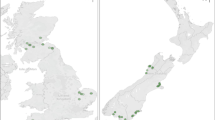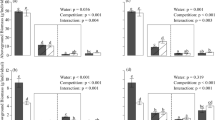Abstract
Understanding the ecology of plant species in their whole range (native and introduced) can provide insights into those that become problematic weeds in the introduced range despite being benign components of the vegetative community in the native range. We studied the morphological traits of Impatiens glandulifera in the native (Indian Himalayas) and introduced (UK) range and evaluated what influences natural enemies and arbuscular mycorrhizal fungi (AMF) have on plant performance. We compared height, total leaf area, root: shoot ratio, natural enemy damage and the colonisation of AMF from individual plants within and between ranges twice in 2010 during the months of June and August. In addition, in August 2010, we estimated the number of reproductive units (expressed as the sum of flowers, seed capsule and seeds) at each site. We found that all morphological traits varied between populations and countries, though in general introduced populations, and the semi-natural population in India, showed higher performance compared to natural native populations. There was only an indication that natural enemy damage, which was significantly higher in the native range, negatively affected reproductive units. Within the introduced range, the percentage colonisation of AMF was negatively associated with plant performance indicating that I. glandulifera may associate with an incompatible AMF species incurring a cost to invasive populations. We conclude that species which are heavily regulated in the native range, though still show high levels of performance, should be considered undesirable introductions into similar ecoclimatic ranges due to the potential that these species will become highly invasive species.





Similar content being viewed by others
References
Abramoff MD, Magelhaes PJ, Ram SJ (2004) Image processing with ImageJ. Biophotonics Int 11:36–42
Andrews M, Maule HG, Raven JA, Mistry A (2005) Extension growth of Impatiens glandulifera at low irradiance: importance of nitrate and potassium accumulation. Ann Bot 95:641–648
Balasuriya J (1999) Shoot population density and shoot weight of clonal tea (Camellia sinensis) at different altitudes in Sri Lanka. Eur J Agron 11:123–130
Beerling DJ, Perrins JM (1993) Impatiens glandulifera Royle (Impatiens roylei Walp.). J Ecol 81:367–382
Blatter E (1927) Beautiful flowers of Kashmir. John Bale Sons and Danielsson, Ltd., London
Blossey B, Nötzold R (1995) Evolution of increased competitive ability in invasive nonindigenous plants: a hypothesis. J Ecol 83:887–889
Caño L, Escarré J, Fleck I, Blanco-Moreno J, Sans FX (2008) Increased fitness and plasticity of an invasive species in its introduced range: A study using Senecio pterophorus. J Ecol 96:468–476
Cockel CP, Tanner RA (2011) Impatiens glandulifera Royle (Himalayan balsam). In: Francis RA (ed) A handbook of global freshwater invasive species. Earthscan, London, pp 67–77
Crawley MJ (1987) What makes a community invisible? In: Gray AJ, Crawley MJ, Edwards PJ (eds) Colonisation succession and stability. Blackwell Scientific, Oxford, pp 429–453
Ebeling SK, Hensen I, Auge H (2008) The invasive shrub Buddleja davidii performs better in its introduced range. Divers Distrib 14:225–233
Environment Agency (2010) Our river habitats: the state of river habitats in England, Wales and the Isles of Man: a snap shot. Environment Agency, London
Erfmeier A, Bruelheide H (2004) Comparison of native and invasive Rhododendron ponticum populations: growth, reproduction and morphology under field conditions. Flora 199:120–133
Fowler SV, Holden ANG (1994) Classical biological control for exotic invasive weeds in riparian and aquatic habitats: practice and prospects. In: de Waal LC, Child LE, Wade PM, Brock JH (eds) Ecology and management of invasive riverside plants. Wiley, Chichester, pp 173–182
Gaertner M, Breeyen A, Cang H, Richardson DM (2009) Impacts of alien plant invasions on species richness in Mediterranean-type ecosystems: a meta-analysis. Prog Phys Geogr 33:319–338
Harner MJ, Mummey DL, Stanford JA, Matthias CR (2010) Arbuscular mycorrhizal fungi enhance spotted knapweed growth across a riparian chronosequence. Biol Invasions 12:1481–1490
Harris CM, Stanford HL, Edwards C, Travis JMJ, Park KJ (2011) Integrating demographic data and a mechanistic dispersal model to predict invasion spread of Rhododendron ponticum in different habitats. Ecol Inform 6:187–195
Herms DA, Mattson WJ (1992) The dilemma of plants: to grow or defend. Q Rev Biol 67:283–335
Hierro JL, Maron JL, Callaway RM (2005) A biogeographical approach to plant invasions: the importance of studying exotics in their introduced and native range. J Ecol 93:5–15
Hulme PE, Bremner ET (2006) Assessing the impact of Impatiens glandulifera on riparian habitats: partitioning diversity components following species removal. J Appl Ecol 43:43–50
Jakobs G, Weber E, Edwards PJ (2004) Introduced plants of the invasive Solidago gigantea (asteraceae) are larger and grow denser than conspecifics in the native range. Divers Distrib 10:11–19
Keane RM, Crawley MJ (2002) Exotic plant invasions and the enemy release hypothesis. Trends Ecol Evol 17:164–170
Kleunen M, Schlaepfer DR, Glaettli M, Fischer M (2011) Preadapted for invasiveness: do species traits or their plastic response to shading differ between invasive and non-invasive plant species in their native range? J Biogeogr 38:1294–1304
Klironomos JN (2002) Feedback with soil biota contributes to plant rarity and invasiveness in communities. Nature 417:67–70
Kofidis G, Bosabalidis AM, Moustakas M (2007) Combined effects of altitude and season on leaf characteristics of Clinopodium vulgare L. (Labiatae). Environ Exp Bot 60:69–76
Krebs C, Gerber E, Matthies D, Schaffner U (2011) Herbivore resistance of invasive Fallopia species and their hybrids. Oecologia. doi:10.1007/s00442-011-2035-8
Levine JM, Pachepsky E, Kendall BE, Yelenik SG, Lambers JH (2006) Plant–soil feedbacks and invasive spread. Ecol Lett 9:1005–1014
Liu H, Stiling P (2006) Testing the enemy release hypothesis: a review and meta-analysis. Biol Invasions 8:1535–1545
McGonigle TP, Miller MH, Evans DG, Fairchild GL, Swan JA (1990) A new method which gives an objective measure of colonization of roots by vesicular–arbuscular mycorrhizal fungi. New Phytol 115:495–501
Olckers T, Hulley PE (1991) Impoverished insect herbivore faunas on the exotic bugweed Solanum mauritianum Scop. relative to indigenous Solanum species in Natal/KwaZulu and the Transkei. J Entomol Soc 54:39–50
Pan H, Liu X, Cai X, Du Z, He F, Wang L, Jia C, Li M (2009) Growth and morphological responses of Fargesia angustissima to altitude in the Wolong nature reserve, southwestern China. Acta Ecol Sin 29:144–149
Pimentel D, McNair S, Janecka J, Wightman J, Simmonds C, O’Connell C, Wong E, Russel L, Zern J, Aquino T, Tsomondo T (2001) Economic and environmental threats of alien plant, animal, and microbe invasions. Agric Ecosyst Environ 84:1–20
Pimentel D, Zuniga R, Morrison D (2005) Update on the environmental and economic costs associated with alien-invasive species in the United States. Ecol Econ 52:273–288
Piskorz R, Klimko M (2006) The effect of Puccinia komarovii Tranzsch. infection on characters of Impatiens parviflora DC. in Galio silvatici-Carpinetum (R. Tx. 1937) Oberd. 1957 forest association. Acta Soc Bot Pol 75:51–59
Polunin O, Stainton A (1997) Concise flowers of the Himalaya. Oxford University Press, Oxford
Prati D, Bossdorf O (2004) Allelopathic inhibition of germination by Alliaria petiolata (Brassicaceae). Am J Bot 91:285–288
Pyšek P, Prach K (1995) Invasion dynamics of Impatiens glandulifera: a century of spreading reconstructed. Biol Conserv 74:41–48
R Development Core Team (2011) R: a language and environment for statistical computing. R foundation for statistical computing,Vienna, Austria. ISBN: 3-900051-07-01
Richards CL, Bossdorf O, Muth NZ, Gurevitch J, Pigliucci M (2006) Jack of all trades, master of some? On the role of phenotypic plasticity in plant invasions. Ecol Lett 9:981–993
Sanders IR (2002) Specificity in the arbuscular mycorrhizal symbiosis. In: van der Heijden MGA, Sanders IR (eds) Mycorrhizal ecology. Springer, Verlag, pp 415–437
Seifert EK, Bever JD, Maron JL (2009) Evidence for the evolution of reduced mycorrhizal dependence during plant invasion. Ecology 90:1055–1062
Sharma BM, Jamwal PS (1988) Flora of upper liddar valleys of Kashmir Himalaya. Scientific Publishers, Jodhpur
Skálová H, Havíčková V, Pyšek P (2012) Seedling traits, plasticity and local differentiation as strategies of invasive species of Impatiens in central Europe. Ann Bot 110:1429–1438
St. Quinton JM, Fay MF, Ingrouille M, Faull J (2011) Characterisation of Rubus niveus: a prerequisite to its biological control in oceanic islands. Biocontrol Sci Technol 21:733–752
Tanner RA (2012) An ecological assessment of Impatiens glandulifera in its introduced and native range and the potential for its classical biological control. Dissertation, Royal Holloway, University of London
Tanner R, Ellison C, Shaw R, Evans H, Gange A (2008) Losing patience with Impatiens: are natural enemies the solution? Outlook Pest Manag 19:86–91
Tanner RA, Varia S, Eschen E, Wood S, Murphy ST, Gange AC (2013) Impacts of an invasive non-native annual weed, Impatiens glandulifera, on above- and below-ground invertebrate communities in the United Kingdom. PLoS ONE 8(6):e67271. doi:10.1371/journal.pone.0067271
Vierheilig H, Coughlan AP, Wyss U, Piché Y (1998) Ink and vinegar, a simple staining technique for arbuscular-mycorrhizal fungi. Appl Environ Microbiol 64:5004–5007
Vilà M, Basnou C, Pyšek P, Josefsson M, Genovesi P, Gollasch S et al (2010) How well do we understand the impacts of alien species on ecosystem services? A pan-European, cross-taxa assessment. Front Ecol Environ 8:135–144
Vogelsang KM, Reynolds HL, Bever JD (2006) Mycorrhizal fungal identity and richness determine the diversity and productivity of a tallgrass prairie system. New Phytol 172:554–562
Widmer TL, Guermache F, Dolgovskaia MY, Reznik SY (2007) Enhanced growth and seed properties in introduced vs. native populations of yellow starthistle (Centaurea solstitialis). Weed Sci 55:465–473
Williams F, Eschen R, Harris A, Djeddour D, Pratt C, Shaw RS, Varia S, Lamontagne-Godwin J, Thomas SE, Murphy ST (2010) The economic cost of invasive non-native species to the British economy. CABI, Wallingford, UK
Williamson M (1996) Biological invasions. Chapman and Hall, London
Zou J, Rogers WE, Sieman E (2007) Differences in morphological and physiological traits between native and invasive populations of Sapium sebiferum. Funct Ecol 21:721–730
Zuppinger-Dingley D, Schmid B, Chen Y, Brandl H, Heijden MGA, Joshi J (2011) In their native range, invasive plants are held in check by negative soil-feedbacks. Ecosphere 2:1–12
Acknowledgments
This work was supported by the UK Department for Environment, Food and Rural Affairs (DEFRA) and the Scottish Executive. We would like to thank all landowners for allowing access to their land for this study. We would also like to thank Sonal Varia, Corin Pratt and Mool Chand Singh for providing field support.
Author information
Authors and Affiliations
Corresponding author
Additional information
Communicated by Lara Souza.
Rights and permissions
About this article
Cite this article
Tanner, R.A., Jin, L., Shaw, R. et al. An ecological comparison of Impatiens glandulifera Royle in the native and introduced range. Plant Ecol 215, 833–843 (2014). https://doi.org/10.1007/s11258-014-0335-x
Received:
Accepted:
Published:
Issue Date:
DOI: https://doi.org/10.1007/s11258-014-0335-x




